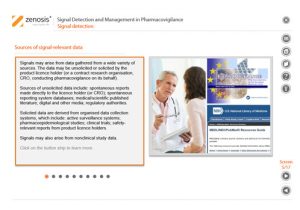Signal Detection and Management in Pharmacovigilance
Course Summary
The fundamental aim of drug safety assessment is to establish what adverse reactions may be caused by a medicinal product. Factors such as seriousness, severity, and frequency of reactions are then taken into account, along with the medical benefit of the drug, in establishing the benefit/risk profile of the product.
Product licence holders and regulatory authorities monitor the safety of licensed drugs to detect adverse reactions that are unexpected qualitatively or quantitatively and that alter benefit/risk balance, and they take risk minimisation action as necessary. Such pharmacovigilance principally involves the identification and evaluation of safety signals in information obtained from a wide range of data sources.
The methods used range from traditional medical assessment of individual spontaneous reports of adverse events, through ‘data mining’ of large databases, observational studies of ‘real world’ prescription and use, to interventional clinical trials.
This module provides a guide to signal detection and management for approved products. The subject is presented as a process comprising four stages: signal detection, signal validation, signal analysis and prioritisation, and risk assessment and minimisation.

Purchasing Information
When you have completed your course order, Zenosis will finalise the setup of your course materials and contact you on the email address that you provide in your order. You can expect this process to be completed within one business day (using the UK business calendar) of completing your payment.
It is therefore essential that you use your real email address for your order, or indicate in the purchase notes the email address to be used for the course set-up, and check that any messages from Zenosis or grapl are not lost in your junk or spam folder.
You will have access to the course module(s) for a period of 180 days after your purchase is complete.
Detailed Course Information
• Identify methods of signal detection and discuss their limitations
• Describe how to accumulate evidence on a causal association between a drug and an event
• Specify factors that increase the priority assigned to a signal, and describe methods of further investigation
• Discuss reassessment of benefit/risk balance in the light of a previously unexpected reaction to a product, and specify actions to minimise risk
All staff working in medical, drug safety, or pharmacovigilance departments of pharmaceutical or biotechnology companies or contract research organisations should have access to this module. It will also be of value to healthcare professionals and regulatory authority personnel.
• Module overview
– This session provides an outline of the course’s scope and objectives, and notes on terminology. It also defines safety signal and explains our approach to the signal detection and management process.
• Signal detection
– The question addressed in this session is: ‘Are there data that may indicate a safety signal?’. The various sources of safety signal-relevant data are set out. ‘Traditional’ signal detection by qualitative review of individual case reports is described, followed by a discussion of quantitative analysis of aggregate data on drug–event associations to detect signals of disproportionate reporting, a process known as ‘data mining’.
• Signal validation
– The question addressed in this session is: ‘Is there a safety signal?’. Steps taken to determine our degree of confidence in the existence of a signal are described. The development of a case series is outlined, and qualitative clues to causality are listed. Approaches to estimation of the incidence of the adverse event(s) in the exposed population are described: including crude approximation of reporting rate, and active surveillance through cohort/prescription-event monitoring and observational study in registries.
• Signal analysis and prioritisation
– The question addressed in this session is: ‘How important is the signal, and do we know enough about it?’. Factors that increase the priority assigned to a signal are listed. The consequences of assignment of a category of risk are outlined. Further investigation of a signal through controlled research, in the form of pharmacoepidemiological studies or clinical trials, is described, and factors influencing a decision to undertake such an investigation are set out.
• Risk assessment and minimisation
– The question addressed in this session is: ‘How does the signal affect benefit/risk balance, and what do we need to do about it?’. Factors affecting re-assessment of the benefit/risk profile of a product in the light of verification of a previously unexpected reaction are set out. Possible risk minimisation actions are listed. Requirements for reporting to regulatory authorities are described, and advice is given on communicating safety information to healthcare professionals and consumers.
• Assessment
– Multiple-choice mastery assessment.
